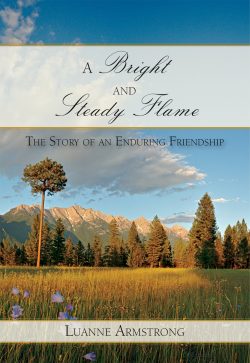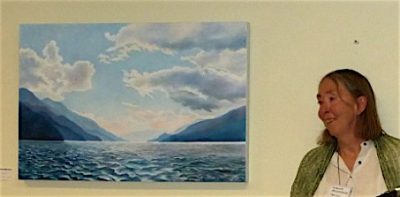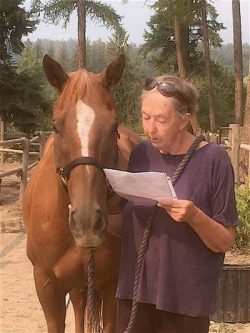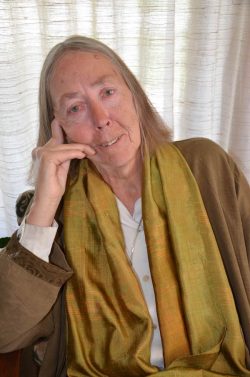#418 Boswell’s woman of words
A Bright and Steady Flame: The Story of an Enduring Friendship
by Luanne Armstrong
Halfmoon Bay: Caitlin Books, 2018
$22.95 / 9781987915822
Reviewed by Lee Reid
First published Nov. 9, 2018
*
 I first came across the Buddhist term Kalyana-mitra in the 1980s when, as a struggling single parent, I was desperate for creative stimulation. Kalyana-mitra is similar to the Celtic term Anam Cara, which means a “friend of the soul:” the muse who confronts your own blindness and holds you accountable to your highest and most rigorous moral truth.
I first came across the Buddhist term Kalyana-mitra in the 1980s when, as a struggling single parent, I was desperate for creative stimulation. Kalyana-mitra is similar to the Celtic term Anam Cara, which means a “friend of the soul:” the muse who confronts your own blindness and holds you accountable to your highest and most rigorous moral truth.
This is a fierce friend whose honesty and compassion forge a rare intimacy through suffering. For writers, their trusted and tough editor may well be the Kalyana-mitra who motivates their best work. For you, this new autobiographical book by well-known author Luanne Armstrong will have a Kalyana-mitra effect, so reader be forewarned!
In A Bright and Steady Flame, we meet Luanne, now aged 69, and her friend of over forty years, Sam. Like many Kootenay seniors, they live alone on large rural properties. Reflecting on their lives, loves, and aging, they realise that “Old age is about being broken” but, despite the challenges this presents, the two friends agree, “We are both joyful and stricken.” As they review the diminishments and strengths that come with aging, Luanne comments, “It is an odd place, far beyond lonely.” Since their twenties, both women have shared the hopes, breakage and renewal of their lives, with a friendship and love that has deepened and grown.
Their friendship infuses Luanne’s new book with a warm glow. They are not resigned or meek about growing old. “The only reasonable reaction to the changes old age demands is sullen fury,” Luanne says, setting a tone of obstinate and inspiring courage that weaves throughout the book. “We have never been old and in grief before, and we don’t know what to do with it.”

Who is Luanne Armstrong? A Bright and Steady Flame tells the autobiographical story of a singular mother, grandmother, author, feminist, and environmental activist whose life periodically burns deeply with physical and emotional pain. She lives in rural Boswell, near Creston, and is the third generation of Armstrongs on a near century-old farm. She is held in the love and support of the surrounding community, which consists of an intriguing cultural mix of farmers, artists, intellectuals and writers, tradesmen, low income and well-off seniors, and many variations of government employees. Luanne is a farmer. Sam operates a woodlot. Like many at Boswell, they are environmental activists. Luanne is also a respected and published writer, whose commitment to her creativity is, in itself, a revelation about risk-taking and courage.
Both seniors have earned their joy. Having struggled through their twenties as single parent “trailer trash welfare mothers,” having both grieved the untimely death of Sam’s much loved husband Ralph (who was also Luanne’s friend); having, in Luanne’s case, suffered hospitalisations when she thought she would die or never write again, growing old is a poignant time. A time of sadness and blessings. They are proud to own their homes, they celebrate grown children and grandchildren, and they both continue to live independently and grow food on their land. Maintaining the properties they love is a considerable feat for many rural and urban seniors. It gets more difficult with aging, and it is more challenging for Sam and Luanne.
With each other’s encouragement, the two friends have achieved remarkable careers. Luanne, with a Ph.D. in creative writing, taught for UBC, and she continues to mentor and provide editing for writers. Sam has achieved her dream of working as a dental hygienist. Throughout A Bright and Steady Flame, their efforts to become economically self-sufficient are a struggle that many rural women and seniors can certainly relate to.
Now, at the apogee of a lifetime of stewarding each other’s children, work, souls, and the environment, they accept that, when they die, quite possibly their cherished properties will be subdivided or developed. They hope that their land will provide future financial benefits for their grandchildren, but they also face the sad prospect that they will not be alive to appreciate those benefits. Assessing what to hang on to, what to grieve, and what to let go of is a tough reality shared by many seniors who, in reading the book, will realise that they are not alone with their fears for the future. The two friends review each other’s scars and achievements with gratitude for the vulnerability and strength that sustains their friendship. Standing at the shaky threshold of global crises and personal mortality, Luanne comments, “I have peace and silence, and I do not know the future.”

Luanne’s autobiography unfolds slowly with details of her rough childhood in a poor family, eking a living on their family farm at Boswell. This smart, canny child felt she had no social skills, but she knew she wanted to write. This was a child who defied limitations. She tells us that she lived as though “living wild was better than dying in a cage.” There was “No trap I couldn’t break out of,” she recalls. She and Sam would hold each other to a commitment to independence and growth throughout their lives.
As her story evolves, we grasp that although life deals her and Sam formidable challenges, nothing would crush Luanne’s commitment to writing and to friendship. Despite abusive relationships and painkiller addiction, Luanne kept writing. She raised four children with almost no money while pursuing advanced university education.
With characteristic chutzpah, during the 70s and 80s when rural women lacked both work and strong voice, Luanne took on the job of newspaper editor in Creston. There and in Nelson she carried forward the “Women and Words” literary conference that was initiated in Vancouver in 1983, thus encouraging rural women, writers in particular, to reach for their creative expression.
As we read about Luanne’s years of intense chronic pain and depression, particularly throughout her mid-sixties, we are pierced with a question that Luanne asks throughout the book. Why is she still alive?
Luanne acknowledges that there were times when death seemed preferable to living in chronic pain. She spent many days alone, exhausted, lying down to avert pain and panic from a formidable combination of head injury, heart condition, and rheumatoid arthritis.

The lifelines that kept her creative and alive infuse us, her readers, with hope for our own aging. One lifeline was her horse Caraigh (“rock” in Gaelic) and the Therapeutic Riding Centre in Creston. They reconnected her to life and to herself. Helping her to heal from depression were friendships with Sam, her family and grandsons, and her multitalented community. So too was returning to the quiet sanctuaries on her family land where she could restore herself from the sheer effort of being alive. To this day, she walks the farm with her beloved dog and cat, and rides Caraigh along familiar forest trails.
I often find that, with creative people, the roots of entrepreneurial survival began young, often with youthful rebellion against the status quo. In Luanne’s case, rebellion does not stop with old age. She describes aging as “darkly luminous.” “It’s a new world, you must think about death and pain but no one wants to talk about it or think about it with you.” With this, we understand that Luanne the writer will, without fail, speak the unspoken. And the connection with Sam is a friendship that hides no secrets.
Both women have supported each other as lifelong environmentalists and feminists. Together, they wrestle through decades of grief and anger at the erosion of the natural world from climate change and from political or corporate greed. Luanne also describes the erosion of our collective social value because of pain or disability, or from the invisibility that accompanies discounting attitudes towards women and the elderly. A Bright and Steady Flame brings a voice to those too vulnerable to speak or be heard, and Luanne’s story invites us into conversation with each other. We are compelled to talk openly about the frightening aspects of living, grief, change, and aging that many prefer to avoid.
Because A Bright and Steady Flame celebrates friendship and shared creative courage, you might be seduced to assume that it eventually melts into a heart-warming story about grandmothers and gratitude. A book to be savoured over many cups of tea. It does and it does not. Luanne and Sam are also the battle-scarred, “Apocalypse Generation,” living, as Ian Brown aptly describes old age, at “The Beginning of the End, or the End of the Beginning” (from Sixty, by Ian Brown. Random House, 2015).
In the 1970s, Luanne and Sam were caught between conflicting cultures. Sam and her husband represented urban refugees fleeing back to the land, and Luanne’s family represented the established rural farm and labour culture. Despite or because of their differences, both women established a lifelong friendship. However, not everyone got along in the community. Luanne describes the cultural clashes with humour and honesty, but that was not the only apocalypse of those times: “We were the result of chemical experiments with DDT and radioactive iodine stemming from nuclear reactors.” There were many other reasons to unite against danger to their community.

Apocalyptic was the baby boomer generation who, in the 60s and 70s, electrified the continent with civil rights movements for social reform, peace, and a new environmental awareness. Together and separately, Luanne and Sam participated in protests for women’s rights and a toxin free environment; they protested infringing oil companies, and they protested abuse of the environment from pesticides. They objected to the Hanford complex of nine nuclear reactors across the border on the Columbia River that threatened the health of their community.
As part of a community of activists, they protected the integrity of Kootenay Lake and surrounding mountains and forests from pollution, logging, and invasive government development. Long before computers galvanized the world, Luanne’s motif of creative entrepreneurship evolved at a time when rural women lacked the money, skills, or opportunities to forge lives autonomous from simply surviving, or from depending on men. As with many women seeking to take charge of their destinies, she and Sam were forced to leave their community to pursue education and opportunities in cities. In Vancouver, Sam trained in dental hygiene and Luanne discovered a vocation and identity at UBC.
Creative expression ignited for Luanne when, as a Ph.D. student in the creative writing program at UBC, she woke up to poetry. It was an epiphany. Poetry shows us how to make meaning from our own personal history. One passage (on p. 88) vibrates off the page when Luanne describes how every piece in a poem, every detail including punctuation, needs to be understood and valued in relation to every other part of the poem. The metaphor is apt for both writing and for old age, because both bring us to explore how all the parts of a story, or a poem, work together, and how we too can find unity and coherence in reviewing our regrets and our lives. Many parts of her autobiography read like exquisite poetry, especially her reflections on the comfort and peace she feels in nature. “I stood on our beautiful cliff face hill, looked out at the blue Selkirk Mountains, the golden stretch of grass and weeds, the shining blue sweep of Kootenay Lake to the north.”
As we read, we feel as though we are standing with Luanne on the cliff face hill, sharing the pain, the beauty, and the mystery of growing old. With her, we too dig backwards to unearth parts of our original selves, and then move the pieces and punctuation forward into our memories and stories. In witnessing Luanne’s life, our own creative expression brightens. We can offer that to each other. We can pass the torch. We can appreciate our friendships.

But A Bright and Steady Flame is not about resting in complacency. “The cure for any illness is to work,” Luanne exhorts us, just when we are ready to bask in the comfort of friendship. She admits that old age has slowed her down; she is less driven. However, with old age, the comforts she could once rely on are no longer a given. Sleep, which brought nightly respite from days of pain, stopped working. To Sam and for us, her readers, she shares the learning: “Some things, like chronic pain and depression and anxiety do heal but slowly, over time. They have to be managed, walked through and cared for, every moment of every day.”
The Apocalypse Generation expected to be annihilated in a nuclear war, but many, like Luanne and Sam, never lost hope that they could change the world for the better. “What we didn’t envision was a future where we … won so many small battles but lost the war anyway,” Luanne says to Sam. Although the two women feel vulnerable with growing old, they still feel hope, and they still expect catastrophe. What endures is friendship. “The gift of true understanding is rare in this world, and friends provide that. Talking to each other is our drug, our exercise, our entertainment, our support. After, we feel better about ourselves and each other.”
This book may well change your worldview about aging. It will certainly encourage you to live as creatively as you can, particularly as you grow older. It is a book about navigating personal annihilation, about being ground into ashes and almost disappearing from life, only to return to the world with a poetic and riveting story that will light a fire in readers’ hearts.
If you have put a creative call on hold for “later,” A Bright and Steady Flame will motivate you to get behind yourself and trust. Trust that life will respond, as long as you walk to the edge of that cliff with your fierce friend and reach out to the unknown.
*

Lee Reid, M. Ed, is a clinical counsellor in Nelson. In 2010, she retired from a career with Mental Health Services in order to enjoy growing old as a writer. She facilitates groups with seniors on creative aging and now, at age 72, she is an activist for intergenerational education. Lee recently completed a project that brought teens and seniors from ages 15 to 92 together at L.V. Rogers Secondary School in Nelson. Their extraordinarily honest and revealing conversations about purpose, aging, and relationships feature in her third book, to be launched in November 2018. Her three books are From a Coastal Kitchen (Hancock House, 1980); Growing Home: The Legacy of Kootenay Elders (Growing Home Elders Press, 2016) www.growinghomestories.com reviewed by Duff Sutherland in The Ormsby Review #369 (September 8, 2018); and Growing Together: Conversations with Seniors and Youth (Nelson CARES Society Press, 2018): www.kootenayseniors.ca
*
The Ormsby Review. More Books. More Reviews. More Often.
Editor/Designer/Writer: Richard Mackie
Publisher/Writer: Alan Twigg
The Ormsby Review is a journal service for serious coverage of B.C. books and authors, hosted by Simon Fraser University. The Advisory Board consists of Jean Barman, Robin Fisher, Cole Harris, Wade Davis, Hugh Johnston, Patricia Roy, David Stouck, and Graeme Wynn. Scholarly Patron: SFU Graduate Liberal Studies. Honorary Patron: Yosef Wosk. As of September, 2018, Provincial Government Patron: Creative BC
“Only connect.” – E.M. Forster

3 comments on “#418 Boswell’s woman of words”
Comments are closed.